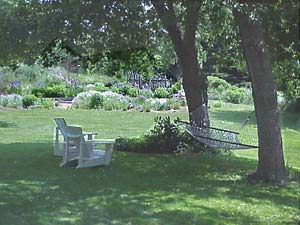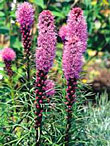 Gardens with Style
Gardens with Style
Choosing a garden style is a little like getting dressed. You might choose a "tie and jacket" look for your garden, using formal, symmetrical plantings, sheared hedges, and rows of flowering plants. Or you might be more of a "blue jeans" gardener, opting for an informal layout with rambling plantings. Or maybe you are somewhere in between.
Formal or Casual?Just like your closet, which may contain formal wear and sweatshirts, and everything in between, you may choose a blend of styles for your gardens. For example, you might like a more formal look for the foundation plantings around your house, where shearing keeps hedges and shrubs inbounds, well-behaved perennials are carefully mulched, and annuals are planted in a symmetrical pattern.
Your island beds--those surrounded by a sea of lawn--might be a little less formal and consist of shrubs and perennials allowed to grow more naturally, with perhaps some annuals tucked into the spaces to add season-long color. Edging and mulching keep the bed looking tidy.
Naturalized GardensThe gardens on the borders of your property might be on the wild side. Here, rambling shrubs, self-sowing wildflowers, and spreading ground covers might predominate. You may not bother with mulching or adding annuals, since this type of garden has a natural beauty all its own.
Generally speaking, the more formal the garden, the more regular maintenance it requires. (Note, however, that all perennial gardens will require some maintenance.)

Consider the size of your perennial bed in relation to its surroundings. For example, a tiny island bed in the middle of a huge lawn may look a little lonely and lost. If you are new to gardening, small plantings near the house are often a good place to begin. Design the beds so that you will be able to enlarge them in subsequent years, rather than overdoing it the first year.
Also consider the size of the plants in relation to the size of the bed. Overly large plants in a small bed can look awkward and out of proportion. On the other hand, a few well-chosen and well-placed large plants can liven up a bed. Similarly, small-leaved, tiny-flowered perennials can get lost in a huge bed. But these, too, have their place and can be used to unify a diverse planting.
Other ConsiderationsShape. Generally, straight lines in a garden give it a more formal feel. You may have walked through formal gardens where each square or triangular bed contained a different herb, for example. If you want a formal garden, you might want to get out the tape measure and square the corners, or use a string and two stakes to create rows. Semicircular gardens can also appear quite formal, and the more symmetrical the plantings, the more formal the appearance.
One of the risks of a formal design is that if one plant in a row dies, or one plant in a symmetrical design falters, the whole design is thrown off. In an informal planting, the loss of a plant or two is usually less noticeable.
For a more informal look, avoid straight lines. Instead, create an outline using gentle curves. Following the contours of the land will help give it a natural feel. Try using a garden hose, or sprinkle limestone, to outline the shape of a new bed. Even if you are creating a new island bed in a flat lawn, where there are no slopes to define the area, you can create an informal, curved outline. If you are hesitant to dig up an irregular, amoeba-shaped hole in your lawn, start with a crescent- or kidney-shaped bed.
Vantage Point. Think about where you'll be spending your time observing your garden. Will you have a bench, or even a breakfast table, in its midst? Will your hammock be next to the garden? Or will you be enjoying your garden primarily from a distance?
We mentioned earlier that bright colors are often best for gardens that will be viewed from afar. Blues, violets, and pastel colors often get lost at a distance, especially in bright sunshine. Save these colors for beds you'll enjoy from a closer vantage point.
Bold textures also hold up better for distant viewing. Plants with large flowers (or lots of small flowers) and heavy foliage will draw attention, while dainty plants with tiny flowers and delicate foliage may get overlooked. Save these for places where they'll get the attention they deserve.